and it ain’t pretty.
- This is a recycled post that was originally published five years ago on June 24, 2013. I thought the subject, photos and the video clip I’ve linked to were fascinating and since many of my current readers have never seen it I decided it was deserving of a rerun for the documentation of behavior it presents (not for the image quality – ravens are buggers to expose properly). For this edition I’ve edited much of the text.
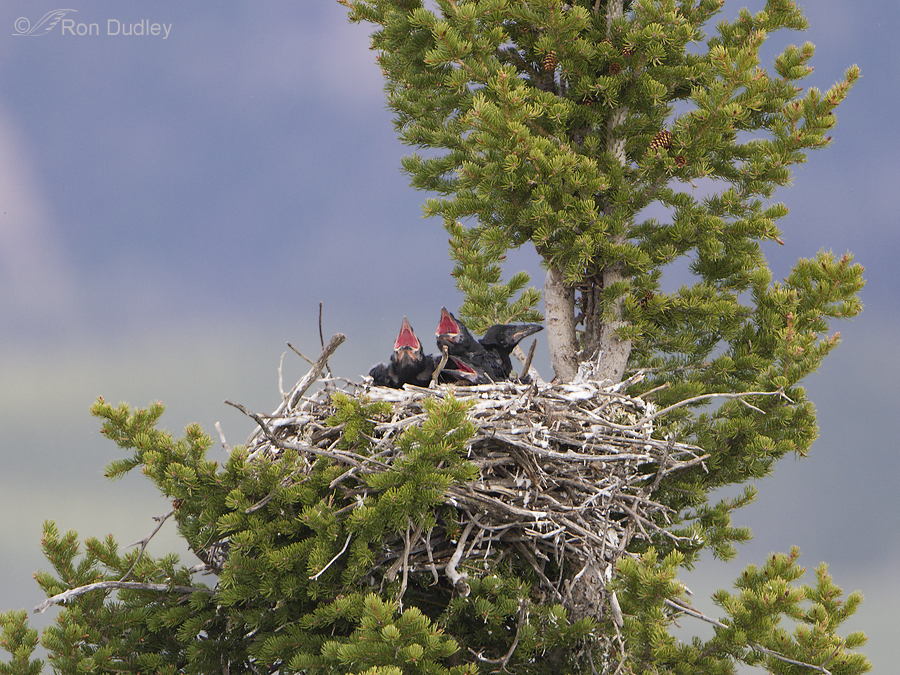
I photographed this nest of four Common Raven chicks 5 years ago at Red Rock Lakes NWR in southwest Montana. I’d watched the development of the nest and chicks during 2 separate camping trips to the area but on this day they had a surprise in store for me.
Here we see all four chicks as three of them begged for food from the parents who were perched nearby. This shot was taken two days after those that follow.
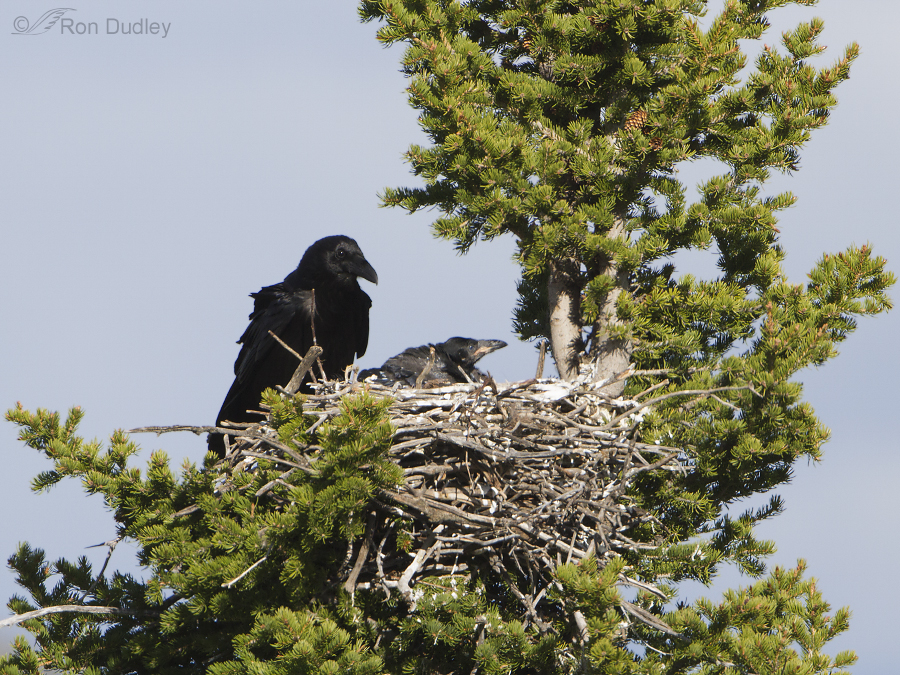
When this parent flew to the nest I was mostly just watching and not clicking the shutter. I had no inkling of what was about to occur.
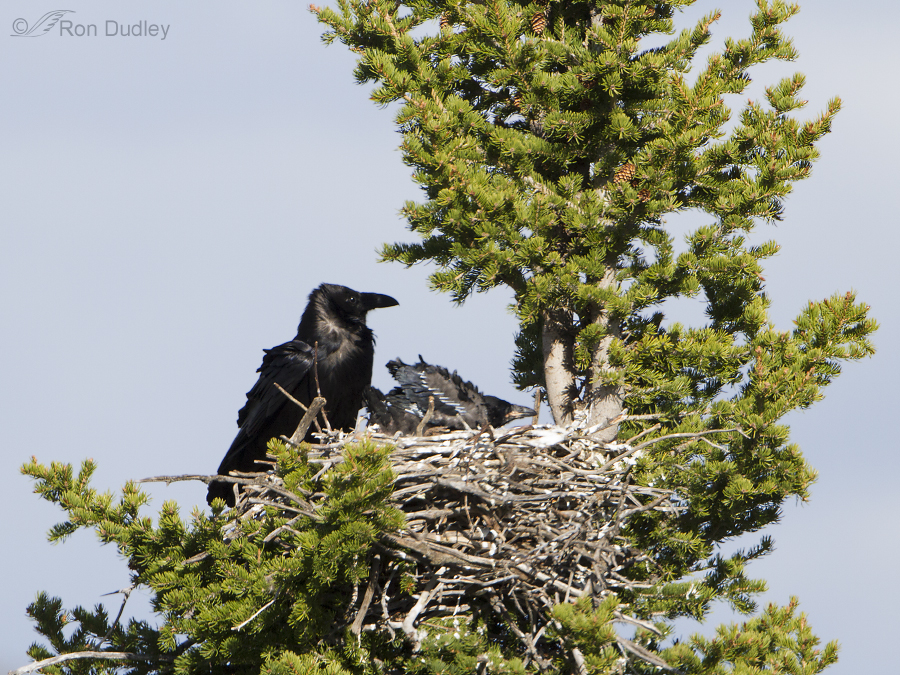
Suddenly one of the chicks began backing up to the edge of the nest and I figured it was about to defecate over the side. I was wrong.
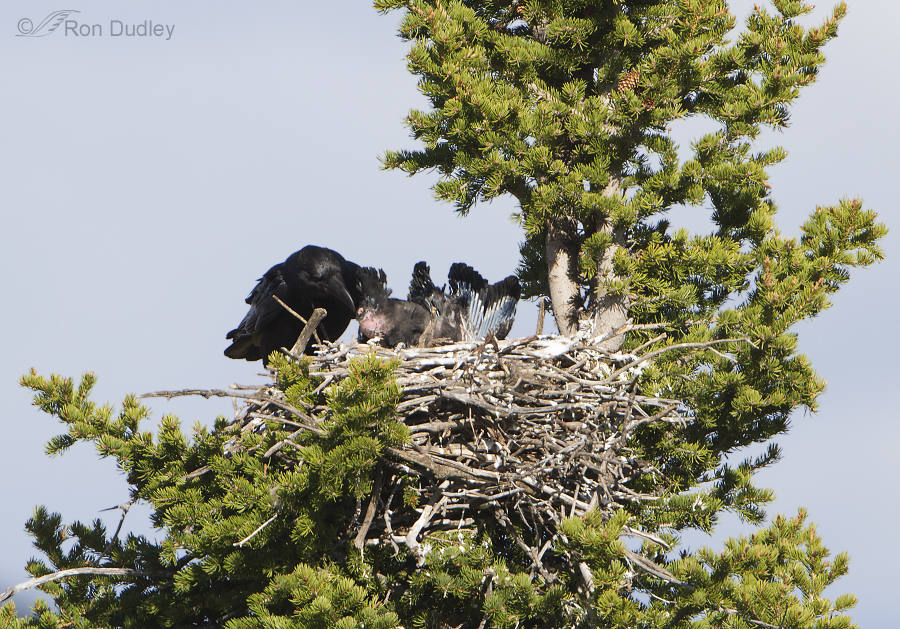
The youngster raised its tail and presented its dilated cloacal opening to the parent…
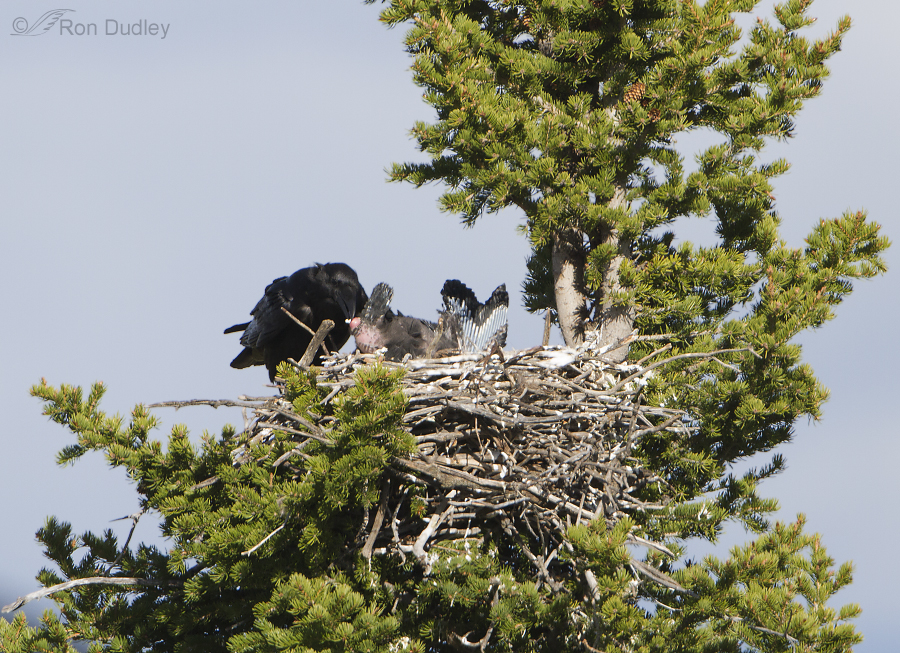
and then its white excreta was presented to the adult bird.
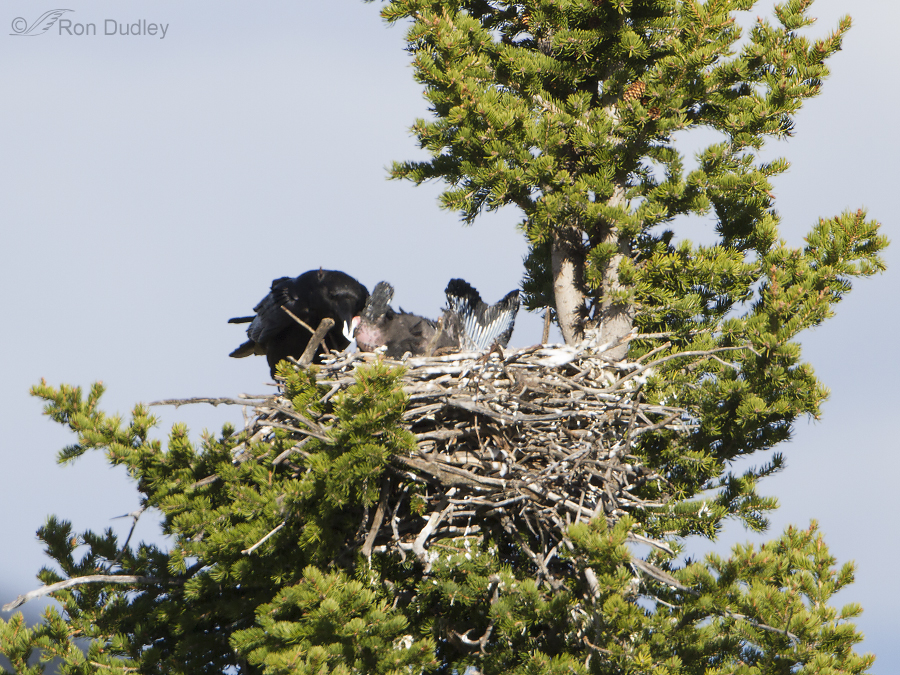
The adult took it into its beak.
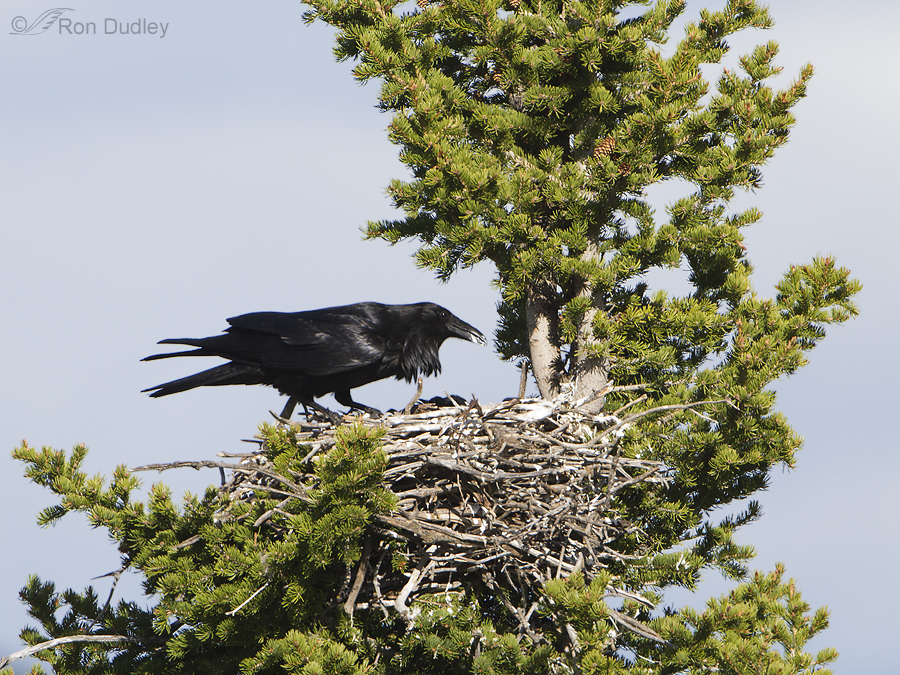
And then apparently ate it.
Here’s what Birds of North America Online has to say about nest sanitation in this species:
- “In Maine, parents of wild birds ate the feces of week-old chicks; captive parents swallow feces of very young chicks. Medium-aged young (2–3 wk old) defecate on rim of nest or parents carry feces away. Older chicks shoot runny feces over edge of nest.”
And ravens aren’t the only species to do this. Here’s a link to an excellent video clip originally shared by my friend Tana Hunter in the comments of the first version of this post. I’d suggest you avoid watching it during breakfast but believe me it’s worth a look-see.
Apparently feeding often stimulates defecation in chicks.
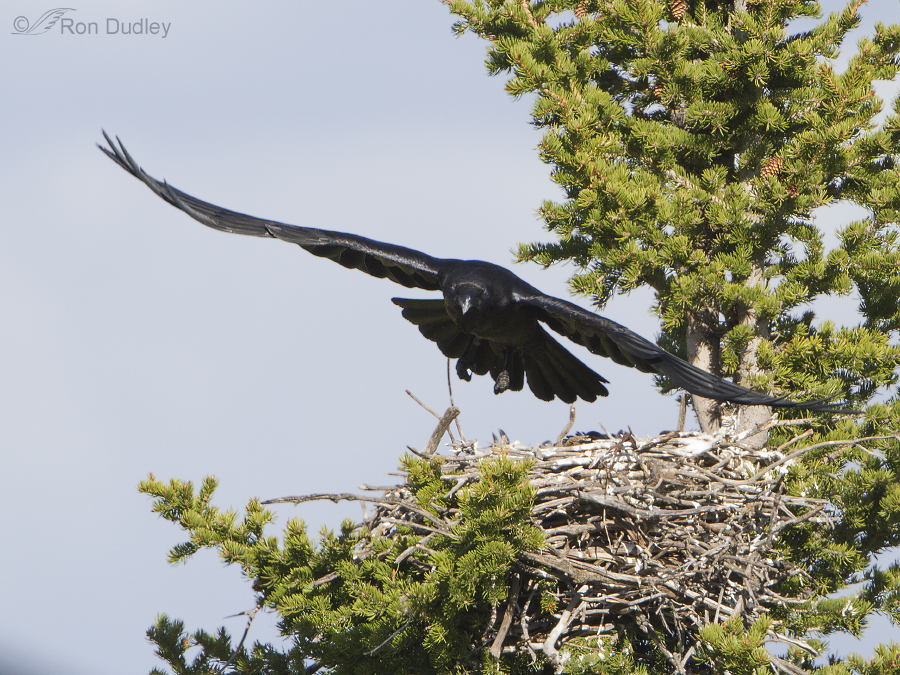
The adult flew off soon after eating the wastes. It has no obvious excreta in its bill.
I was quite surprised that the chick deliberately presented its feces directly to the adult and that the parent actually picked them up as they exited the chick. I guess it was my assumption that the adult would remove them from the nest some time after they were deposited and drop them elsewhere but in thinking about it that would be very difficult to do given the unconsolidated mess they appear to be.
From the looks of the nest I’m guessing that at this age the chicks are beginning to shoot their feces over the edge of the nest on occasion.
I suspect that some of my readers know much more about this than I do but in my naiveté I sure thought this little episode was interesting
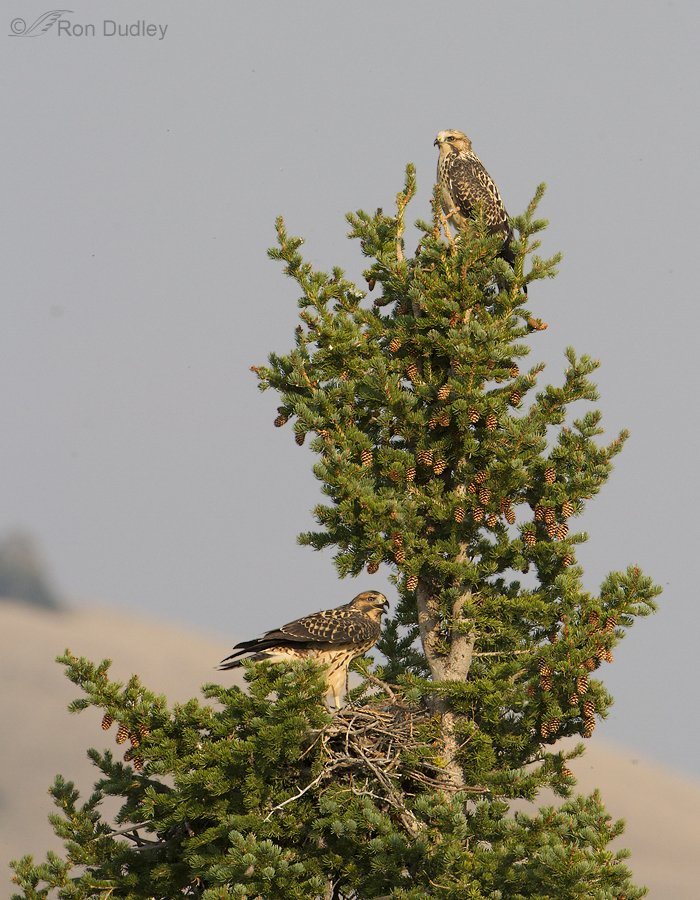
One more interesting observation – the previous year this same nest had been used by Swainson’s Hawks to raise two youngsters. This image, taken on August 22 of that year, shows the two juveniles raised in the nest that summer. Another thing that fascinates me is nest recycling by different species but that’s a subject for another post.
I just realized there’s a lot of recycling in this edition of Feathered Photography – the blog post itself, the feces of the chick and the nest.
Ron
Note: These photos were taken from a road while I was shooting from inside my pickup. I never approached the nest.


Parenting, without much regard to the species, is hard work. Sometimes rewarding hard work.
And I thank dedicated parents (and teachers) for their diligence.
And goodness, those gaping maws in the first…
Yup, they’re ravenous birds, EC (word-play intended).
Aaaand yet another reason I never wanted to be a parent. Blargh! 😖😝 If I were that raven, it would be “nevermore” for sure!
Some folks just aren’t cut out for it, Marty – nothing wrong with that. I quit at one…
I figured that 190+ kids a year were enough! 😉
Plus, I get to ooh and aww over my foster kittens and poopies…er…puppies, watch them go to their forever families at 8-10 weeks, then get another litter to take home. 🐶🐱
Marty. I am with you. And am pretty certain I would have been less than stellar at the important job. I couldn’t teach either.
There are mammals and birds that eat the feces of their young, many young mammals have to be stimulated to urinate or defecate by licking. Besides keeping nest/bedding clean and less noticeable to predators, I have wondered if there is some enzyme connection passed between the parent and offspring that is part of the process.
April, in some cases it’s at least partially a matter of getting more nutrition, as in the case of rabbits. Rabbit diets are composed largely of cellulose which is very difficult to digest so the first time their wastes come out partially undigested. Another pass-through makes it more efficient for them.
Well, that’s the last time I let a raven kiss me.
Don’t be so picky with your puckerers, Martha! 🙂
Still doing it—amazing!!! Still sharing new, interesting information every morning. I keep forgetting hoe msny years now, but always something new—every morning!!!
Thanks very much, Patty.
Ron, you are a font of knowledge! I truly learn something new every time I read your site. Truly appreciate the education and also, that last pic of the Swainson’s Hawks is really nice.
Thanks, Joanne. What I don’t know I look up. And when I think I know something I often look it up anyway… 🙂
Isn’t the era of instant information via the internet amazing! We use to walk the isles of libraries and often still not find the answer.
Hated the inefficiency of those old card catalogues.
Well wouldn’t you know… I sat down with bowl of cereal in hand this morning to read your post! 😂 I did not know the eating of the fecal sac was part of early bird parenting. I did know they cleaned the nest every day…there are usually Grackles nesting nearby and for some reason they prefer to deposit the sacs on my patio in the back or on alternate nesting years on the driveway in front after leaving the nest.! I will say they use the same flight pattern…all droppings are deposited within a 2 foot wide path. Needless to say the hose never gets put away until they have moved on. 🙂 This behavior shouldn’t surprise me though after having our labrador have a litter of eleven pups and watching her keep them clean until they started to eat regular food!
Interesting grackle observations, Kathy. Hope you were still able to eat your cereal…
Very interesting post, including the video. Now I’m wondering about the Barn Swallow nest we watch. There’s plenty of poop on the ground under it, but it seems like that happens when the chicks are moving toward fledging. I’ve never seen what they do, but it seems like there would be a lot more stuff on the ground if the babies were pooping over the edge from the beginning. Interesting to think about.
Susan, here’s what BNA Online has to say on that subject regarding Barn Swallows:
“By day 12, nestlings back up to nest edge and defecate over rim, and as a result feces often accumulate below nest. Before then, adults swallow or carry fecal sacs from nest.”
That seems to fit in well with your own observations.
Educational photos for sure Ron. Something that I was not familiar with. Nature somehow provides for just about everything. Always remarkable to me how quickly birds and other wildlife grow up and merge into the adult world so rapidly. House Finches out back here who were just in the nest a couple weeks ago are out flying around the backyard with their parents. The eagles I observe are now about 18 weeks old and almost as large as their parents and will probably fly off to a more northern location sometime next month. We humans on the other hand take forever to grow up and become adults, and of course some of us never grow up. 🙂
Thanks for the education.
Everett Sanborn, Prescott AZ
Thank you, Everett. I’m one of those humans in that latter category!
Wow, I had no idea Ron. Very interesting! Thanks for another educational post.
Thank you, Ed.
Glad you followed up with the nest – usually I’m not too squeamish BUT for some reason……….;) I’ve seen them remove from a nest, but not this! Magpie nests are recycled by GHO’s here.
Hope it wasn’t too upsetting for you, Judy. Yes, GHO’s famously use nests of other raptor species and some corvids.
Just a “knee jerk” reaction in the moment – I’m “over it”. Sanitation is an important issue for sure!
Good.
I very timely post for me, Ron. I’ve been watching an Eastern Bluebird nest outside my window and wondered what the adults were carrying out of the nestbox – something white. I didn’t know that the chicks produce waste in little packets which the adults remove periodically. I find myself sharing this information with anyone who will listen! Anything we can learn about bird behavior is pretty neat to me, even if it is about feces! Thanks for the post and the pictures.
Thanks, Carol. I think the membrane enclosing the wastes in that “packet” is pretty fragile. I’ve often wondered how they do it without breaking it open.
The wastes are white because they include both feces and concentrated uric acid (instead of “urine” as we know it). Uric acid is pasty and very white.
Good Morning, how interesting is this blog, although not very appetizing. I must admit that I’ve never thought about this subject.
The birds are clean and certainly don’t want their chicks wallowing in their own waste.
Thank you, Ron.
PS Just came back from Bear Lake…saw only a few birds but many wooden fence posts that made me thing of you.
I hope I didn’t ruin your breakfast, Alice.
I also hope you saw bluebird boxes on some of those fence posts.
I didn’t see any bluebird boxes but I did get a photo of 2 pelicans on Bear Lake…pretty exciting.
Your posts are amazing. I learn so much. Thanks!
I appreciate that, Chuck.
Another great bird behavior post Ron. Very interesting!
Observation of 12 boxes over the years, Bluebird boxes will show adults periodically removing initially egg shells and as the young grow fecal matter from the nest/box. In my opinion Bluebirds are the cleanest and Tree Swallows don’t even come close, even though I’ve seen them remove fecal matter. I think it is tough for the parent Tree Swallow to deal with young that spray the inside of the box.
Thanks, Dick. I’ve also watched various birds removing chick fecal sacs – including Mountain Bluebirds at the same refuge as in my post.